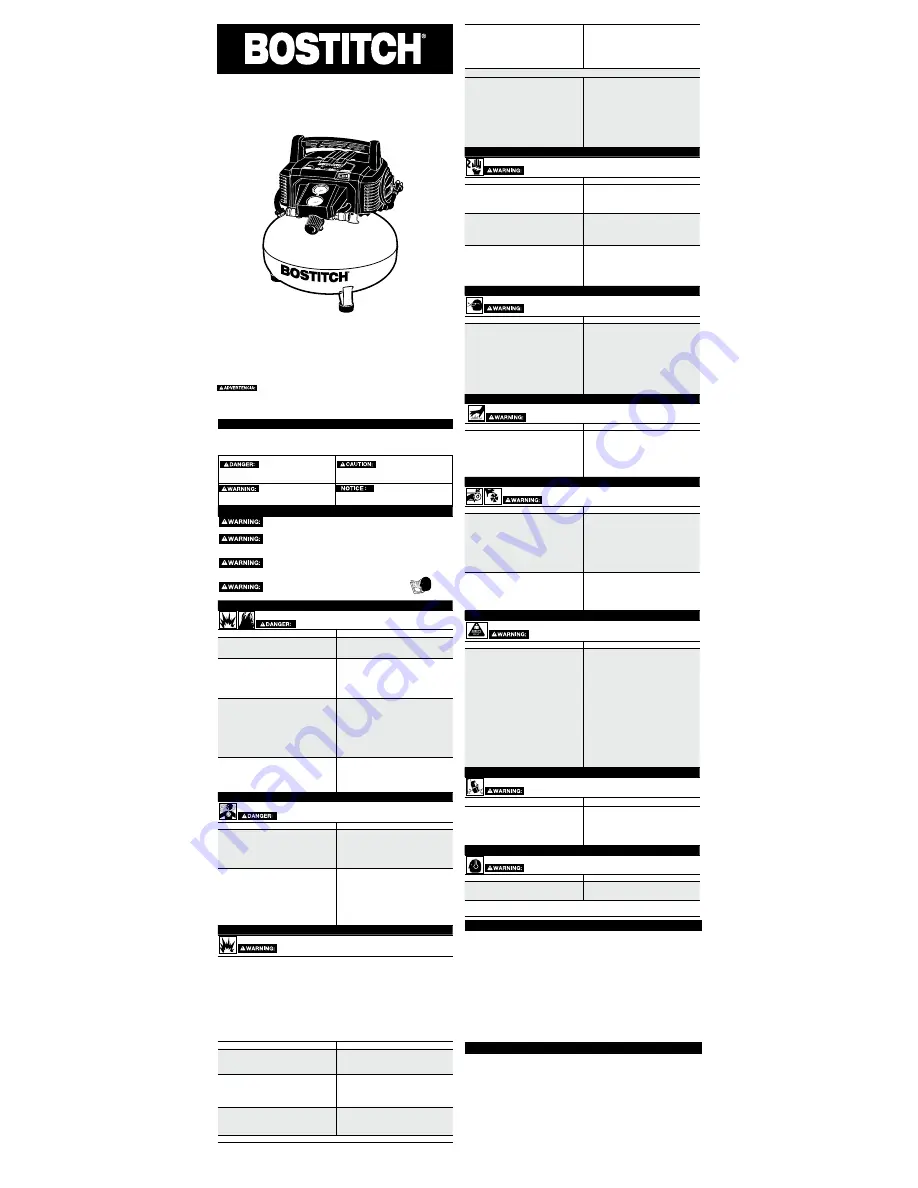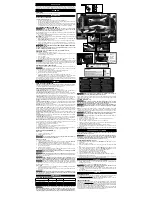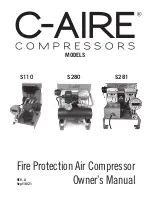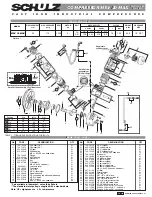
OPERATION and MAINTENANCE MANUAL
MANUALES DE OPERACIÓN y MANTENIMIENTO
LES MANUELS D’UTILISATION et D’ENTRETIEN
INSTRUCTIVO DE OPERACIÓN, CENTROS
DE SERVICIO Y PÓLIZA DE GARANTÍA.
LÉASE ESTE INSTRUCTIVO
ANTES DE USAR EL PRODUCTO.
SAFETY GUIDELINES - DEFINITIONS
This manual contains information that is important for you to know and understand.
This information relates to protecting YOUR SAFETY and PREVENTING EQUIPMENT
PROBLEMS. To help you recognize this information, we use the symbols below. Please
read the manual and pay attention to these symbols.
Indicates an imminently
hazardous situation which, if not avoided,
will
result in
death or serious injury
.
Indicates a potentially
hazardous situation which, if not avoided,
may
result in
minor or moderate injury.
Indicates a potentially
hazardous situation which, if not avoided,
could
result in
death or serious injury.
Indicates a practice
not
related to personal injury
which, if not
avoided,
may
result in p
roperty damage.
IMPORTANT SAFETY INSTRUCTIONS
This product contains chemicals known to the State of California to
cause cancer, and birth defects or other reproductive harm.
Wash hands after handling
.
Some dust contains chemicals known to the State of California to cause
cancer, birth defects or other reproductive harm such as asbestos and lead in lead based
paint.
Not for use with foodstuffs or ingestible products. This product
contains chemicals known to the State of California to cause cancer, and birth defects or
other. reproductive harm. Wash hands after handling.
To reduce the risk of injury, read the instruction manual.
SAVE THESE INSTRUCTIONS
HAZARD
RISK OF EXPLOSION OR FIRE
WHAT CAN HAPPEN
HOW TO PREVENT IT
• It is normal for electrical contacts within
the motor and pressure switch to spark.
• Always operate the compressor in a
well ventilated area free of combustible
materials, gasoline, or solvent vapors.
• If electrical sparks from compressor come
into contact with flammable vapors, they
may ignite, causing fire or explosion.
• If spraying flammable materials, locate
compressor at least 20' (6.1 m) away
from spray area. An additional length of
air hose may be required.
• Store flammable materials in a secure
location away from compressor.
• Restricting any of the compressor
ventilation openings will cause serious
overheating and could cause fire.
• Never place objects against or on top of
compressor.
• Operate compressor in an open area at
least 12" (30.5 cm) away from any wall or
obstruction that would restrict the flow of
fresh air to the ventilation openings.
• Operate compressor in a clean, dry well
ventilated area. Do not operate unit in
any confined area. Store indoors.
• Unattended operation of this product
could result in personal injury or property
damage. To reduce the risk of fire, do
not allow the compressor to operate
unattended.
• Always remain in attendance with the
product when it is operating.
• Always turn off and unplug unit when not
in use.
HAZARD
RISK TO BREATHING (ASPHYXIATION)
WHAT CAN HAPPEN
HOW TO PREVENT IT
• The compressed air directly from your
compressor is not safe for breathing. The
air stream may contain carbon monoxide,
toxic vapors, or solid particles from the air
tank. Breathing these contaminants can
cause serious injury or death.
• Never use air obtained directly from the
compressor to supply air for human
consumption. The compressor is not
equipped with suitable filters and
in-line safety equipment for human
consumption.
• Exposure to chemicals in dust created by
power sanding, sawing, grinding, drilling,
and other construction activities may be
harmful.
• Sprayed materials such as paint, paint
solvents, paint remover, insecticides,
weed killers, may contain harmful vapors
and poisons.
• Work in an area with good cross
ventilation. Read and follow the safety
instructions provided on the label or
safety data sheets for the materials you
are spraying. Always use certified safety
equipment: NIOSH/OSHA respiratory
protection or properly fit ting face mask
designed for use with your specific
application.
HAZARD
RISK OF BURSTING
Air Tank:
On February 26, 2002, the U.S. Consumer Product Safety Commission
published Release # 02-108 concerning air compressor tank safety:
Air compressor receiver tanks do not have an infinite life. Tank life is dependent upon
several factors, some of which include operating conditions, ambient conditions, proper
installations, field modifications, and the level of maintenance. The exact effect of these
factors on air receiver life is difficult to predict.
If proper maintenance procedures are not followed, internal corrosion to the inner wall of
the air receiver tank can cause the air tank to unexpectedly rupture allowing pressurized
air to suddenly and forcefully escape, posing risk of injury to consumers.
Your compressor air tank must be removed from service by the end of the year shown on
your tank warning label.
The following conditions could lead to a weakening of the air tank, and result in a violent
air tank explosion:
WHAT CAN HAPPEN
HOW TO PREVENT IT
• Failure to properly drain condensed water
from air tank, causing rust and thinning of
the steel air tank.
• Drain air tank daily or after each use.
If air tank develops a leak, replace it
immediately with a new air tank or
replace the entire compressor.
• Modifications or attempted repairs to the
air tank.
• Never drill into, weld, or make any
modifications to the air tank or its
attachments. Never attempt to repair a
damaged or leaking air tank. Replace
with a new air tank.
• Unauthorized modifications to the safety
valve or any other components which
control air tank pressure.
• The air tank is designed to withstand
specific operating pressures. Never make
adjustments or parts substitutions to
alter the factory set operating pressures.
Attachments & accessories:
• Exceeding the pressure rating of air tools,
spray guns, air operated accessories,
tires, and other inflatables can cause
them to explode or fly apart, and could
result in serious injury.
• Follow the equipment manufacturers
recommendation and never exceed the
maximum allowable pressure rating of
attachments. Never use compressor to
inflate small low pressure objects such
as children’s toys, footballs, basketballs,
etc.
Tires:
• Over inflation of tires could result in
serious injury and property damage.
• Use a tire pressure gauge to check the
tires pressure before each use and while
inflating tires; see the tire sidewall for the
correct tire pressure.
NOTE:
Air tanks, compressors and similar
equipment used to inflate tires can fill
small tires very rapidly. Adjust pressure
regulator on air supply to no more than
the rating of the tire pressure. Add air in
small increments and frequently use the
tire gauge to prevent over inflation.
HAZARD
RISK OF ELECTRICAL SHOCK
WHAT CAN HAPPEN
HOW TO PREVENT IT
• Your compressor is powered by electricity.
Like any other electrically powered
device, if it is not used properly it may
cause electric shock.
• Never operate the compressor outdoors
when it is raining or in wet conditions.
• Never operate compressor with
protective covers removed or damaged.
• Repairs attempted by unqualified
personnel can result in serious injury or
death by electrocution.
• Any electrical wiring or repairs required
on this product should be performed
by authorized service center personnel
in accordance with national and local
electrical codes.
•
Electrical Grounding:
Failure to provide
adequate grounding to this product
could result in serious injury or death
from electrocution. Refer to
Grounding
Instructions
paragraph in the
Installation
section.
• Make certain that the electrical circuit
to which the compressor is connected
provides proper electrical grounding,
correct voltage and adequate fuse
protection.
HAZARD
RISK FROM FLYING OBJECTS
WHAT CAN HAPPEN
HOW TO PREVENT IT
• The compressed air stream can cause
soft tissue damage to exposed skin and
can propel dirt, chips, loose particles, and
small objects at high speed, resulting in
property damage or personal injury.
• Always wear certified safety equipment:
ANSI Z87.1 eye protection (CAN/CSA
Z94.3) with side shields when using the
compressor.
• Never point any nozzle or sprayer toward
any part of the body or at other people or
animals.
• Always turn the compressor off and
bleed pressure from the air hose and
air tank before attempting maintenance,
attaching tools or accessories.
HAZARD
RISK OF HOT SURFACES
WHAT CAN HAPPEN
HOW TO PREVENT IT
• Touching exposed metal such as the
compressor head, engine head, engine
exhaust or outlet tubes (J, Fig. 2), can
result in serious burns.
• Never touch any exposed metal parts on
compressor during or immediately after
operation. Compressor will remain hot
for several minutes after operation.
• Do not reach around protective shrouds
or attempt maintenance until unit has
been allowed to cool.
HAZARD
RISK FROM MOVING PARTS
WHAT CAN HAPPEN
HOW TO PREVENT IT
• Moving parts such as the pulley, flywheel,
and belt can cause serious injury if they
come into contact with you or your
clothing.
• Never operate the compressor with
guards or covers which are damaged or
removed.
• Keep your hair, clothing, and gloves
away from moving parts. Loose clothes,
jewelry, or long hair can be caught in
moving parts.
• Air vents may cover moving parts and
should be avoided as well.
• Attempting to operate compressor with
damaged or missing parts or attempting
to repair compressor with protective
shrouds removed can expose you to
moving parts and can result in serious
injury.
• Any repairs required on this product
should be performed by authorized
service center personnel.
HAZARD
RISK OF UNSAFE OPERATION
WHAT CAN HAPPEN
HOW TO PREVENT IT
• Unsafe op
er
a
tion of your compressor
could lead to se ri ous in jury or death to
you or others.
• Review and understand all instructions
and warnings in this manual.
• Be come fa mil iar with the op eration and
con trols of the air compressor.
• Keep operating area clear of all persons,
pets, and obstacles.
• Keep chil
dren away from the air
compressor at all times.
• Do not operate the product when
fatigued or under the influence of alcohol
or drugs. Stay alert at all times.
• Never defeat the safety features of this
prod uct.
• Equip area of operation with a fire
extinguisher.
• Do not op er ate machine with missing,
broken, or un au tho rized parts.
• Never stand on the compressor.
HAZARD
RISK OF FALLING
WHAT CAN HAPPEN
HOW TO PREVENT IT
• A portable compressor can fall from a
table, workbench, or roof causing damage
to the compressor and could result in
serious injury or death to the operator.
• Always operate compressor in a stable
secure position to prevent accidental
movement of the unit. Never operate
compressor on a roof or other elevated
position. Use additional air hose to reach
high locations.
HAZARD
RISK FROM NOISE
WHAT CAN HAPPEN
HOW TO PREVENT IT
• Under some conditions and duration
of use, noise from this product may
contribute to hearing loss.
• Always wear proper hearing protection
during use.
SAVE THESE INSTRUCTIONS
FOR FUTURE USE
SPECIFICATIONS
Model No.
BTFP02012
Bore
1.875" (47.6 mm)
Stroke
1.250" (31.8 mm)
Voltage/Hz-Single Phase
120/60
Minimum Branch Circuit Requirement
15 amps
Fuse Type
Time Delay
Air Tank Capacity
6 Gallon (22.7 liters)
Approximate Cut-in Pressure
120 psig
Approximate Cut-out Pressure
150 psig
SCFM @ 40 psig
3.7 *
SCFM @ 90 psig
2.6 *
Regulated Pressure Rating (Approximate)
3–150 psi
Quick Connect Type
1/4" (6.4 mm) Industrial
*Tested per ISO 1217
Refer to Glossary for abbreviations.
GLOSSARY
Become familiar with these terms before operating the unit.
CFM:
Cubic feet per minute.
SCFM:
Standard cubic feet per minute; a unit of measure of air delivery.
PSIG:
Pounds per square inch gauge; a unit of measure of pressure.
Code Certification:
Products that bear one or more of the following marks: UL
®
, CUL,
CULUS, ETL
®
, CETL, CETLUS, have been evaluated by OSHA certified independent safety
laboratories and meet the applicable Standards for Safety.
Cut-In Pressure:
While the motor is off, air tank pressure drops as you continue to use
your accessory. When the tank pressure drops to a certain lower level the motor will restart
automatically. The low pressure at which the motor automatically restarts is called "cut-in"
pressure.
Cut-Out Pressure:
When an air compressor is turned on and begins to run, air pressure in
the air tank begins to build. It builds to a certain high pressure before the motor automati-
cally shuts off, protecting your air tank from pressure higher than its capacity. The high pres-
sure at which the motor shuts off is called "cut-out" pressure.
Branch Circuit:
Circuit carrying electricity from electrical panel to outlet.
BTFP02012
OIL FREE PORTABLE AIR COMPRESSOR
COMPRESSEUR D’AIR PORTATIF SANS HUILE
COMPRESOR DE AIRE SIN ACEITE PORTÁTIL
Part No. N410108 March 15




















